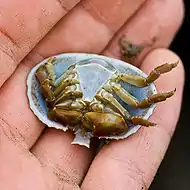| Cryptolithodes sitchensis | |
|---|---|
 | |
| Scientific classification | |
| Domain: | Eukaryota |
| Kingdom: | Animalia |
| Phylum: | Arthropoda |
| Class: | Malacostraca |
| Order: | Decapoda |
| Suborder: | Pleocyemata |
| Infraorder: | Anomura |
| Family: | Lithodidae |
| Genus: | Cryptolithodes |
| Species: | C. sitchensis |
| Binomial name | |
| Cryptolithodes sitchensis | |
Cryptolithodes sitchensis, known as the umbrella crab,[2] is a species of lithodid crustacean native to coastal regions of the northeastern Pacific Ocean, ranging from Sitka, Alaska to Point Loma, California.[3] Its carapace extends over its legs such that when it pulls in its legs, it resembles a small stone. It lives in rocky areas from the low intertidal to depths of 17 m (56 ft).[3]
Description


Cryptolithodes sitchensis has a half-moon shaped carapace extending over all of its eight walking legs and two chelipeds, giving them their common names of turtle crab, umbrella crab or helmet crab. The carapace can be 5–10 cm (2.0–3.9 in) at the adult stage and has scalloped edges. This carapace ranges from neutral sandy colors to bright oranges, reds, and purples.[4]: 192, 255 The rostrum extends forwards from the carapace, gradually widening before ending abruptly. From above, only the eyes and second antennae are visible. The ventral side is commonly white in color, and the abdomen is protected by multiple hard plates that lack raised margins.[4]: 407 The chelipeds are smooth. The fifth pair of walking legs are located at the posterior and are difficult to distinguish.[5]
Range
Cryptolithodes sitchensis can be found from southern Alaska to southern California, where they are common.[5][6] They live within 18 m (59 ft) of the intertidal zone along the exposed coasts of the Pacific Ocean.[5] Intertidal species of Lithodidae prefer habitats of cooler temperatures ranging from 0–25 °C (32–77 °F) and temperatures of 16 °C (61 °F) during larval development. This causes a restriction on their distribution as water temperatures change due to global warming.[7]
Identification
The distinguishing characteristic between C. sitchensis and C. typicus is that the rostrum of C. sitchensis is wider distally than proximally, while the opposite is found in C. typicus. Also, C. typicus has raised margins of the abdominal segments, while C. sitchensis does not.[4]: 407
Life history
The larvae of C. sitchensis have six tergites at the megalopal stage. Upon reaching the adult stage, the first and second abdominal segments have fused and the sixth tergite and telson are whole. C. sitchensis males and females have symmetrical abdomens, yet females have a greater number of accessory plates on the left side of the third tergite.[8]
Natural history
Cryptolithodes sitchensis may be hard to spot due to its rough, rock-like exterior, but it is easily caught due to its slow movements. Found most commonly in the intertidal zone, this species feeds on coralline algae. The reason for the diverse colorations of its carapace may be camouflage with its surroundings.[9]
Threats
Natural predators of C. sitchensis include larger marine invertebrates, such as octopuses, seabirds, and marine mammals, such as otters.
A major threat to C. sitchensis in Southern California is deforestation and its effects on the giant kelp forests around the Channel Islands National Park. The forests of Macrocystis pyrifera form a protective canopy, fostering the ideal temperature for various species that are temperature-sensitive, such as C. sitchensis, and the growth of macroalgae and coralline algae needed for their survival.[10]
References
- ↑ von Brandt, Johann Friedrich (1853). "Ueber eine neue Art der Gattung Cryptolithodes (Cryptolithodes sitchensis)" [About a new species of the genus Cryptolithodes (Cryptolithodes sitchensis)]. Bulletin de la Classe physico-mathématique de l'Académie Impériale des Sciences de Saint Pétersbourg (in German). 11: 254–256. ISSN 1029-998X.
- ↑ Snow, C. Dale (April 1978). "Interesting Crabs of Oregon". Oregon Wildlife. Vol. 33, no. 4. Oregon Fish and Wildlife Commission. p. 6.
- 1 2 Jensen, Gregory C. (1995). Pacific Coast Crabs and Shrimps. Sea Challengers. ISBN 0-930118-20-0. LCCN 94039292.
- 1 2 3 Kozloff, Eugene N. (1993). Seashore Life of the Northern Pacific Coast: An Illustrated Guide to Northern California, Oregon, Washington, and British Columbia. Seattle, WA: University of Washington Press. ISBN 0-295-96084-1. LCCN 83001130.
- 1 2 3 Lamb, Andy; Hanby, Bernard P. (2005). Marine Life of the Pacific Northwest: A Photographic Encyclopedia of Invertebrates, Seaweeds and Selected Fishes. Photography by Bernard P. Hanby. Harbour Publishing. p. 313. ISBN 1-55017-361-8.
- ↑ Ricketts, Edward F.; Calvin, Jack (1962). Between Pacific Tides. Revisions by Joel W. Hedgpeth (Third ed.). Stanford University Press. p. 92.
- ↑ Hall, Sally; Thatje, Sven (October 15, 2009). "Global bottlenecks in the distribution of marine Crustacea: temperature constraints in the family Lithodidae" (PDF). Journal of Biogeography. 36 (11): 2125–2135. doi:10.1111/j.1365-2699.2009.02153.x. Archived (PDF) from the original on July 24, 2018 – via the University of Southampton.
- ↑ McLaughlin, Patsy A.; Lemaitre, Rafael (2000). "Aspects of evolution in the anomuran superfamily Paguroidea: one larval prospective" (PDF). Invertebrate Reproduction and Development. 38 (3): 159–169. doi:10.1080/07924259.2000.9652453. S2CID 55956527. Archived (PDF) from the original on February 27, 2012.
- ↑ Cowles, Dave (2005). "Cryptolithodes sitchensis Brandt, 1853". Walla Walla University. Archived from the original on October 18, 2007. Retrieved May 11, 2010.
- ↑ Graham, Michael H. (2004). "Effects of Local Deforestation on the Diversity and Structure of Southern California Giant Kelp Forest Food Webs". Ecosystems. 7 (4): 341–357. doi:10.1007/s10021-003-0245-6. JSTOR 3658821. S2CID 36589268.
External links
 Media related to Cryptolithodes sitchensis at Wikimedia Commons
Media related to Cryptolithodes sitchensis at Wikimedia Commons Data related to Cryptolithodes sitchensis at Wikispecies
Data related to Cryptolithodes sitchensis at Wikispecies- CalPhotos
- Video of C. sitchensis